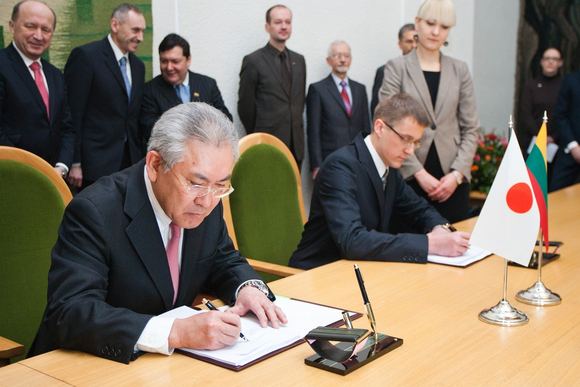
Lithuania, Hitachi Initial Concession Agreement for Baltic Nuclear Power Plant
Publication: Eurasia Daily Monitor Volume: 9 Issue: 65
By:

On March 30, Lithuania and Japan’s Hitachi Corporation initialed the concession agreement to build a Baltic regional nuclear power plant at Visaginas in Lithuania. The Lithuanian government had selected Hitachi and its subsidiary, Hitachi-General Electric of the US, as the strategic investor for this project, following a tender last year. The other competitor, Toshiba-Westinghouse, had been considered because it also involved an American partner – a consideration of special importance to Lithuania (see EDM, July 19, 2011; February 20, 2012). Estonia and Latvia plan to join Lithuania as shareholders in this regional project. Poland had evidenced interest, but has recently adopted a wait-and-see attitude (BNS, Delfi.Lt, March 30, 31, April 2).
Hitachi vice-president Masaharu Hanyu and the Lithuanian chairman of the Concession Commission, Zygimantas Vaiciunas, initialed the agreement in Vilnius. The concession agreement provides the contractual framework for a project company to design, construct, operate, and ultimately to decommission the plant after the expiry of the reactors’ service life. Hitachi and Hitachi-GE Nuclear Services shall install two Advanced Boiling Water Reactors (ABWRs), with a capacity of 1,300 megawatts each. This is a third-generation nuclear reactor type, in service and on order in Japan and abroad, with a proven record of reliability.
Under the agreement, Hitachi-GE shall also provide other equipment, supply-chain consulting, and nuclear fuel. The project’s cost is estimated at €5 billion ($6.7 billion), with 50 percent to 70 percent (depending on the shareholder agreement’s structure) to be borrowed and the remainder to be invested by shareholders. The loans are planned to be repaid from the plant’s revenue, within 18 years of the start of electricity production.
The project company at this stage includes Hitachi as the strategic investor, Hitachi-GE as technology provider, and Lithuania’s state enterprise Visagina Nuclear Power Plant as a shareholder with a minimum 34 percent stake under Lithuanian law. Estonia and Latvia are interested in joining the project as shareholders through their respective electricity companies, Eesti Energia and Latvenergo. Negotiations are ongoing on the terms of a shareholder agreement. The participant countries as well as the strategic investor are expected to finance the project as shareholders. They would receive electricity from the plant proportionately based on their respective shares in the investment.
Lithuania’s government approved the concession agreement on March 29, and the Parliament is expected to ratify it in June. This would clear the way for signing the concession agreement, as well as for Latvia and Estonia to sign a shareholder agreement. The project company would then commission the designing work and hold a tender to select a construction contractor. The Final Investment Decision should be made by a March 2015 deadline. The time-frame for completion and first electricity production is 2020-2022.
The Visaginas nuclear plant project involves the largest-ever foreign direct investment in Lithuania and the Baltic States. According to Lithuanian Prime Minister, Andrius Kubilius, the agreement with Hitachi amounts to a vote of confidence in the local capacity to absorb and manage investments on this scale. The Estonian and Latvian prime ministers, Andrus Ansip and Valdis Dombrovskis, conferring with Kubilius at the three Baltic States’ prime-ministerial meeting, had expressed their support for the project and Lithuania’s signing of the concession agreement with Hitachi (BNS, March 8).
Visaginas should replace the Soviet-era nuclear power plant at a proximate location, then known as Ignalina. That plant had supplied the Baltic States with electricity from the plant’s two RBMK-type reactors, commissioned in 1983 and 1987, with a capacity of 1,360 megawatts each. The European Union, however, required their closure as a safety precaution, long before the expiry of their license, and stipulating their closure in the EU’s accession treaty with Lithuania. The two reactors were accordingly shut down in 2004 and 2009, respectively.
That shutdown severely complicated the Baltic States’ economic and energy-security situation. It turned Lithuania from a regional exporter of electricity into an importer of Russian electricity, aggravating also Latvia’s dependence on Russia. Ignalina’s closure left the region with a major deficit of electrical power. It raised costs to consumers, and added electricity dependence to the gas and oil dependence of the Baltic States on Russia. The Baltic States therefore regard the Visaginas nuclear plant project as an imperative, provided that the electricity produced there is cost-competitive. This determination will largely depend on construction costs and the ammortization of loans and investments.
The site of Visaginas is located next to Ignalina. The EU committed itself to bear the lion’s share of Ignalina’s decommissioning costs. That decommissioning is a joint Lithuanian-EU undertaking. EU auditors recently confirmed that Ignalina’s decommissioning is running behind schedule and above budget by wide margins. The company Nukem, specializing in nuclear plant decommissioning projects, is in charge of the troubled Ignalina project. Nukem was a German company when hired, but it soon metamorphosed into a Russian company.
The EU Commission has already allocated €1.37 billion ($1.82 billion) for Ignalina decommissioning operations through 2013. Lithuania has requested €800 million ($1.06 billion) for the next EU budget perspective, 2014-2020; but the EU is only offering €210 million ($279 million) for that purpose through 2017 in its draft budget for that period (adding to Lithuania’s proposed €100 million [$133 million] contribution).
If this is the EU’s last word, it would impose an onerous burden on Lithuania’s economy, after having demanded Ignalina’s premature closure as a sine-qua-non precondition to Lithuania’s accession, without concern for a replacement solution. This solution is now moving within sight, but Lithuania should not be required to bear a disproportionate share of Ignalina decommissioning costs at the same time when it needs to make a major investment in the new nuclear plant project.




